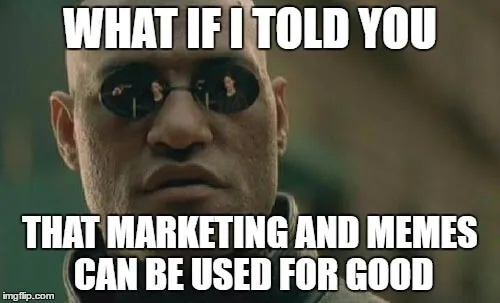Marketers are always looking for ways to stay relevant and current in the constant battle to gain the attention and continued loyalty of their customers. This can sometimes feel like a dangerous balancing act as brands try to avoid the pitfalls of negative brand promotion while producing interesting and engaging content. Memes have become a popular way to deliver a message in a short, impactful and funny way and have become a viral trend that does not appear to be going away any time soon. “Meme” was actually a word originally used by Richard Dawkins in 1976 as “any sharable cultural artifact that spreads through a culture like wildfire.”
The popularity and effectiveness of memes (if used correctly) make it a great way for brands to communicate with their audiences and stay memorable in a positive way. Since they are meant to be humorous, the chances of increased engagement and sharing on social media is pretty high. So why aren’t all marketing teams building memes into their brand strategies?
For some companies, memes don’t resonate with their audience, so using them would not be effective for their business. Others are afraid of falling flat in their messaging, or using the wrong pop cultural reference and getting dragged across the Internet. This may cause marketers to hold back or use the tactic less.

There is a lot of potential in using memes and here are a few tips to help companies create the right ones for their marketing campaigns:
Know Your Audience
This is probably the most important part of choosing an effective meme. Pop culture references are a big part of meme creation, so if you don’t know what your audience knows or understands, you can end up with a boring or confusing meme. For example, a brand like GameStop might not get as much engagement with a meme referencing Taylor Swift as it would a popular gaming YouTuber. Also, if your brand is international, think of how your references translate across countries. You will have to use targeted marketing to ensure that a meme is shown to the right audience.
Make Sure Your Memes are Funny and Relatable
It may sound obvious, but the funnier your meme is, the more likely it is shared and remembered. Also, the stronger your audience can connect with a meme, the better your engagement results. Try testing out your meme with coworkers or peers to see what kind of reaction you get. If it needs to be explained or doesn’t get a positive reaction, you may need to go back to the drawing board.
Remember, Memes Have a Short Shelf Life
In very rare cases, popular memes can be reused even months after they initially circled the Internet. Most of the time; however, the effectiveness of a meme does not last more than a few days or weeks. This means that it is important for you to keep up with what is currently trending and take advantage of the popularity of a meme in real-time. The worst mistake is using a very outdated meme because it will make you seem out of touch with your audience.
Reusing Memes is Great, but Don’t Be Afraid to Create Your Own
If you’re going to reuse a meme and alter the text or video, that is fine and, in fact, very common. Just make sure you understand where that meme comes from and what the original intent was behind using the meme. If you don’t know, then don’t use it. As an alternative, you can create your own memes. This approach is slightly more difficult, but if you get it right, it can be a huge success.
Memes tend to resonate with a younger audience and are impactful because they are visual, short, memorable, relatable and funny. If you decide to use memes in your marketing strategy it can be a great tool to earn more trust and loyalty from your customers.
Author: Kendra Clarke


